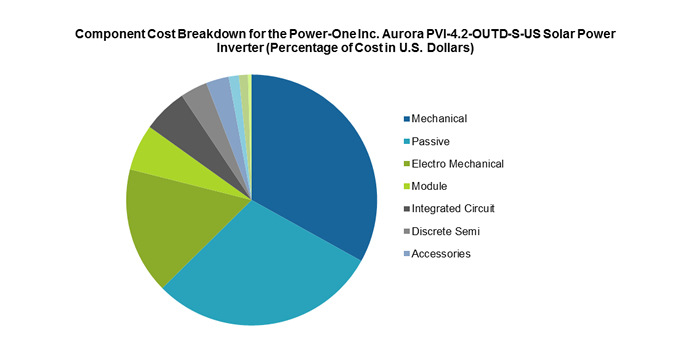In its first-ever dissection of a solar power inverter, IHS has determined the bill of materials (BOM) of a major manufacturer's product, providing a path-setting benchmark for cost reduction in a market expected to undergo rapid price erosion in the coming years.
IHS iSuppli Teardown Analysis of Solar Inverter, Identifying the Cost-Reduction Opportunities
Contributed by | IHS
In its first-ever dissection of a solar power inverter, IHS has determined the bill of materials (BOM) of a major manufacturer’s product, providing a path-setting benchmark for cost reduction in a market expected to undergo rapid price erosion in the coming years.
The Aurora PVI-4.2-OUTD-S-US Inverter from Power-One Inc. carries a BOM of $641.47, according to an IHS iSuppli Teardown Analysis report from information and analysis provider IHS (NYSE: IHS). When the $47.87 manufacturing and test costs are added in, the total expense to produce the inverter rises to $689.35, as presented in the table attached.
Solar power inverters, also known as photovoltaic PV inverters, are electronic systems that convert the DC power generated by solar panels into AC power that is needed for local use, or into power that can be fed into the electricity grid. An inverter is half power management system and half embedded computer.
The solar power inverter market has strong growth prospects, with worldwide unit shipments set to rise to 30.2 million units in 2015, up from just 4 million in 2011.
The robust potential has attracted a slew of competitors, with IHS identifying 125 distinct brands participating in the space. With the large number of players, price reduction will be the major factor driving market dynamics in the coming years.
“Companies in the solar inverter business will have to engage in aggressive price reductions to remain competitive,” said Greg Sheppard, senior director of PV research at IHS. “With prices to decline by an average of 10 percent annually for the next several years, continued reductions in inverter BOMs will be needed to keep costs in line with pricing.”
Power-One’s market position
Power-One in the second half of 2010 ranked as the world’s second-largest solar power inverter supplier, with a 12.5 percent share of global market share measured in terms of gigawatts. With its strong market position, its products provide a good representation of the types of inverters available in the market.
The PVI-4.2-OUTD-S-US is a power inverter intended for outdoor use. Of the various models in the company’s flagship Aurora product line, this unit features the highest-rated maximum AC output power of 4,200 watts.
Market surveys indicate that typical dealer prices for the Aurora PVI-4.2-OUTD-S-US range from approximately $2,100 to $2,600.
Where the costs are
When looking at the costs of the Aurora PVI-4.2-OUTD-S-US, the most expensive component category is the mechanical segment, which accounts for 33.1 percent—or one-third—of the inverter’s total BOM. These mechanical components make extensive use of commodity metals whose pricing can vary.
“Inverters like the PVI-4.2-OUTD-S-US have a major opportunity for cost reduction, as prices decline for copper and aluminum,” said Kevin Keller, senior principal analyst, teardown analysis, for IHS. “These commodity metals are responsible for the bulk of the 38 pounds of weight of the PVI-4.2-OUTD-S-US. Prices already have come down from highs earlier this year, and could decline more in the future.”
Inverters also could reduce enclosure costs by employing lower-cost sources for heat sinks. For example, the Aurora PVI-4.2-OUTD-S-US includes a machined heat sink made from extruded aluminum with an estimated cost of $39.13, representing about 6 percent of the total BOM.
Furthermore, the enclosure of the product is made of stamped/formed aluminum and is priced at $42.26, or 6.6 percent of the BOM.
Another prime candidate for cost reduction of the inverter is its passive components. Passives represent the second most expensive component group of the PVI-4.2-OUTD-S-US, at 29.6 percent of the total BOM.
The inductors account for a significant portion of this passive expense. For example, the PVI-4.2-OUTD-S-US integrates two pieces of wound copper foil, double-cut C core inductors from Endela Electronics Co. Ltd., priced at $72.10, or 11.2 percent of the overall BOM.
“Passive costs in inverters could be reduced as manufacturers make greater use of lower-cost sources for devices like inductors,” Keller observed.

IHS (NYSE: IHS) is the leading source of information and insight in critical areas that shape today’s business landscape, including energy and power; design and supply chain; defense, risk and security; environmental, health and safety (EHS) and sustainability; country and industry forecasting; and commodities, pricing and cost. Businesses and governments in more than 165 countries around the globe rely on the comprehensive content, expert independent analysis and flexible delivery methods of IHS to make high-impact decisions and develop strategies with speed and confidence. IHS has been in business since 1959 and became a publicly traded company on the New York Stock Exchange in 2005. Headquartered in Englewood, Colorado, USA, IHS employs more than 5,500 people in more than 30 countries around the world.
The content & opinions in this article are the author’s and do not necessarily represent the views of AltEnergyMag
Comments (0)
This post does not have any comments. Be the first to leave a comment below.
Featured Product

